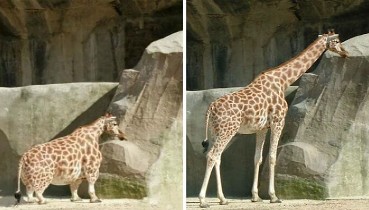

In Arizona, There is a Petrified Opal Tree Trunk (About 225 Million Years Old)
Petrified wood: what is it? In essence, it is a fossil. Petrification is the process through which a tree or plant that resembles a tree turns into stone through mineralization. It happens when plant matter is buried by silt or volcanic ash and is shielded from decomposition by organisms and oxygen. The original plant material is then replaced by silica, calcite, pyrite, or another inorganic (but attractive) substance like opal as groundwater with high concentrations of dissolved solids passes through the sediment.
The original woody substance becomes a fossil as a result, frequently displaying retained characteristics of the bark, wood, and cellular structures. Naturally, it takes millions of years for that to occur.

Petrified wood is a three-dimensional depiction of the original organic material, in contrast to other plant fossils, which are often imprints or compressions. Some petrified wood specimens are so perfectly preserved that people don’t recognize they are fossils until they pick them up and are startled by how heavy they are. These specimens have very flawless preservation, which makes them uncommon. However, examples with easily visible wooden structures and bark are relatively common.
The images below serve as evidence that petrified wood is one of nature’s most stunning creations.










Recommended Videos
 35 Hilarious Examples Of The Worst Designed Dresse1425 views
35 Hilarious Examples Of The Worst Designed Dresse1425 views 66 Amazing Wood Sculptures Made From The Pieces Found On Beaches34179 views
66 Amazing Wood Sculptures Made From The Pieces Found On Beaches34179 views-
Advertisements
 Two Artists Create Miniature Birds By Using Hand-Cut Painted Paper722 views
Two Artists Create Miniature Birds By Using Hand-Cut Painted Paper722 views 97 Majestic And Unique Birds That Amaze People With Their Beauty31881 views
97 Majestic And Unique Birds That Amaze People With Their Beauty31881 views A female Brazilian gardener has uncovered the mystery of an uncommon fruit.463 views
A female Brazilian gardener has uncovered the mystery of an uncommon fruit.463 views This is an old cedar tree about 800 years old that stands at the east foot of Mt. Daimanji, Oki Islands, Japan.4847 views
This is an old cedar tree about 800 years old that stands at the east foot of Mt. Daimanji, Oki Islands, Japan.4847 views Potter Park Zoo Welcomes Birth Of Rare Eastern Bongo, A Critically Endangered Species53 views
Potter Park Zoo Welcomes Birth Of Rare Eastern Bongo, A Critically Endangered Species53 views Artist Arranges Natural Objects Into Stunning Mandalas20 views
Artist Arranges Natural Objects Into Stunning Mandalas20 views



